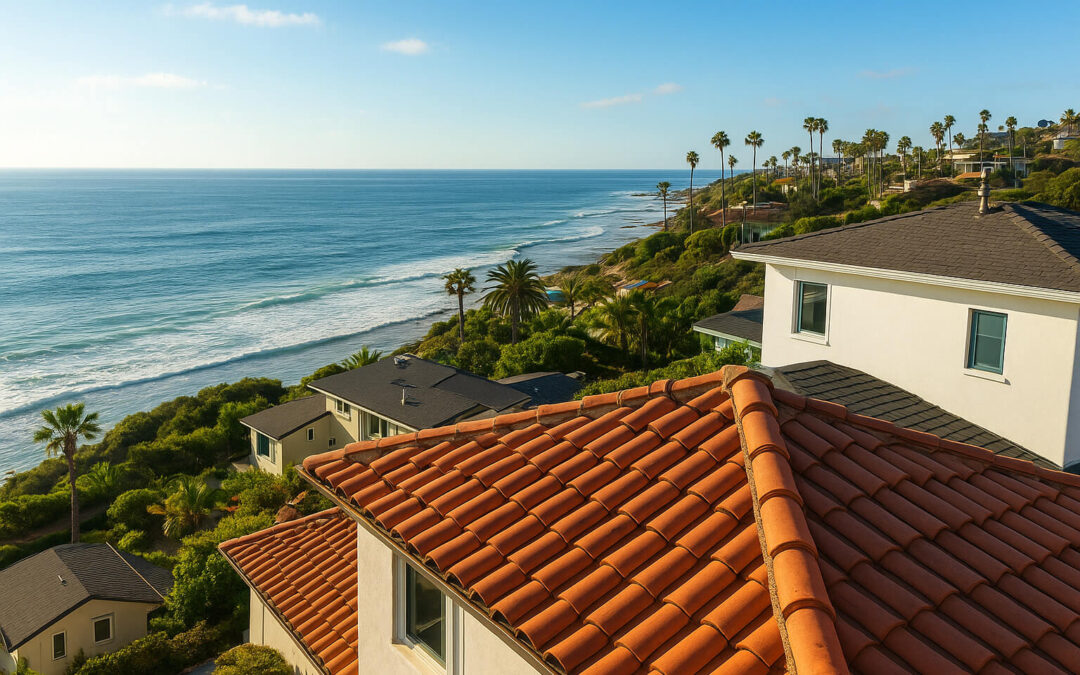Living in Encinitas comes with ocean views, cool breezes, and a climate that’s hard to beat—but that same salty, moisture-rich air that makes our mornings so refreshing is also working against your roof every single day. If you want your home to stay protected (and avoid premature roof replacement), regular maintenance and smart material choices aren’t optional—they’re essential.
In this guide, we’ll walk you through how salt air affects different types of roofing, what you can do to slow down damage, and the proactive steps that keep Encinitas homes looking sharp and leak-free all year long.
Why Salt Air is a Silent Roof Killer
Encinitas homeowners have to contend with one of the most corrosive natural forces in our environment: airborne salt. It rides in with the breeze and clings to your roof, vents, gutters, and flashing. Over time, it causes:
- Metal corrosion — rust on flashing, fasteners, vent covers, and any exposed metal.
- Faster wear on coatings and finishes — salt breaks down paint and sealants, exposing materials to moisture.
- Accelerated aging for shingles — salt and humidity weaken the bond between asphalt granules, leading to bald spots and leaks.
If you’re close enough to smell the ocean from your driveway, your roof is already in the fight.
Step 1: Pick Materials That Can Handle the Coast
Not all roofing materials are created equal. In Encinitas, longevity comes down to choosing products built for a marine climate.
Best Performers for Coastal Homes:
- Clay Tile: Classic for Southern California, clay doesn’t rust, resists salt, and can last 50+ years if properly maintained.
- Concrete Tile: Similar benefits to clay with slightly more weight; highly resistant to salt and sun.
- Standing Seam Metal Roofing: When made with coastal-grade aluminum or galvanized steel with a marine coating, it’s durable and corrosion-resistant.
- High-End Architectural Shingles: Choose “coastal” or “salt-resistant” rated shingles with reinforced granule adhesion.
- Avoid: Bare steel, low-grade asphalt shingles, and untreated wood shakes—they simply don’t hold up in our salty environment.
Step 2: Wash the Salt Away
Regular rinsing is your first line of defense. Just like you’d hose down patio furniture, your roof benefits from a salt wash.
- Frequency: At least twice a year, more often if you’re within a mile of the shoreline.
- Method: Use a gentle, low-pressure rinse from the ground or a safe ladder position. Avoid high-pressure washing—it can strip away protective coatings or dislodge shingles and tiles.
- Bonus Tip: Include gutters and downspouts. Salt build-up here causes hidden rust and blockages.
If you’re not comfortable doing this yourself, schedule a professional roof wash with a contractor experienced in coastal homes.
Step 3: Stay Ahead with Inspections
Salt-related damage often starts small—tiny rust spots on flashing, hairline cracks in sealant—but once it spreads, repairs become more invasive and expensive.
- Schedule: Once a year minimum, ideally in spring before the coastal fog season.
- What to Check:
- Flashing and fasteners for rust
- Shingles for curling or bald spots
- Tiles for cracks or slips
- Sealant around vents and skylights
- Professional Bonus: A roofer can spot early underlayment issues you’d miss from the ground.
Step 4: Keep the Air Moving
Salt air damage accelerates when moisture lingers. Proper ventilation allows your roof to “breathe” and helps reduce humidity that can lead to rot or mold.
- Ridge Vents: Promote even airflow along the peak of your roof.
- Soffit Vents: Allow fresh air to enter at the eaves.
- Attic Fans: Can help in particularly humid pockets or during warmer months.
Step 5: Repair Quickly, Replace Wisely
In a coastal setting, ignoring a small issue is the fastest route to a major one. If you spot rusted flashing, cracked tiles, or missing shingles, get them fixed right away.
When it is time to replace your roof:
- Choose coastal-rated materials.
- Upgrade to stainless steel or corrosion-resistant fasteners.
- Consider a “cool roof” option to fight Encinitas heat and lower AC costs.
How JCIS Roofing Protects Encinitas Homes
With over 25 years working along the San Diego coastline, JCIS Roofing knows exactly how to keep salt air from stealing years off your roof’s life. Our approach includes:
- Coastal-specific material recommendations
- Annual inspections with detailed photo reports
- Sealant upgrades on every roof we install
- Proper ventilation design for long-term performance
We don’t just put a new roof on your home—we make sure it’s ready for Encinitas weather from day one.
FAQs
Q: How often should I wash my roof in Encinitas?
At least twice a year, more if you live within a mile of the beach.
Q: What is the best roofing material for a coastal home?
Clay or concrete tile, or coastal-grade metal roofing, offer the longest life near the ocean.
Q: Can I use regular shingles near the coast?
Yes, but choose high-quality, coastal-rated architectural shingles to resist salt damage.
Q: How do I stop rust on my roof?
Regular rinsing, annual inspections, and replacing rusted fasteners with stainless steel versions help prevent spreading.

